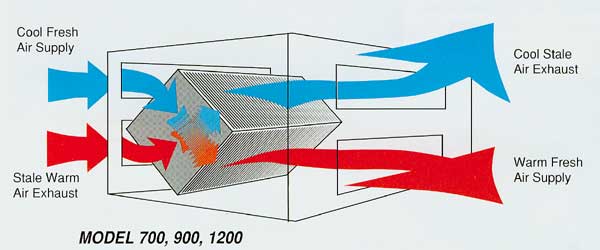|
Fixed-plate exchangers
Fixed plate heat exchangers, commonly known as air-to-air
heat exchangers, can reduce laboratory energy consumption.
The transfer of waste energy from exhaust to laboratory
make-up air depends on the location and characteristics
of the air streams. These air streams are separated by plates,
which are usually augmented with fins. The heat exchange
principle is simple: warm exhaust air heats a fixed plate,
which, in turn, heats the cool make-up air on the other
side of the plate. This exchanger uses no transfer media
other than the plate-forming wall of the exchanger

| Why I prefer PLATE over WHEEL
|
| |
| 1-There is a cross leakage
in energy recovery wheels.Cross leakage through the
energy recovery wheels ranges from 2% to 5% between
the supply and exhaust air streams . In many applications
(especially where odors, pathogens or other harmful
pollutants are present), it is clearly unacceptable
for exhaust air (EA) to leak into the outdoor air (OA)
or fresh air stream being furnished to the conditioned
space.I don't want to give air form toilettes to dining
room .Some standart give permission to toillettes air
but I don't !!! |
|
|
| 2-The remedy applicable to wheel systems
is to increase OA airflow thereby pressurizing
this air stream. As long as this pressure gradient is
maintained, the majority of the leakage is from OA to
EA, thus reducing, if not eliminating the exhaust air
transfer. This imbalance can represent a substantial
inefficiency, e.g. 700 CFM of OA may be required to
provide 500 CFM to the conditioned space. It is not
uncommon for “lost air” to account for 25-30%
of a wheel’s rated airflow. |
| |
| 3-Power consumption:A
dedicated motor is required for rotation of the wheel.
For systems installed in cold-weather climates, an effective
defrost mechanism will require yet another draw on available
power. PLATE HEAT EXHANGERS has no moving parts at all. |
| |
| 4-Maintenance is generally
acknowledged as the real Achilles’ heel of wheel
systems. Wheel-type ERV is perhaps the least forgiving
of all HVAC equipment. If not properly serviced, it
will fail – often within a few years of installation.
Routine maintenance generally requires disassembly of
the unit, cleaning/reconditioning of the wheel, re-assembly
and re-calibration of the mechanicals. This is a time-consuming
and costly process requiring the attention of a trained
technician. In addition, during the maintenance process,
no energy recovery takes place, i.e. the heating or
cooling equipment must work to condition raw, outside
air. |
| |
Air
to air plate heat exchanger selection software (from HOVAL)
|

